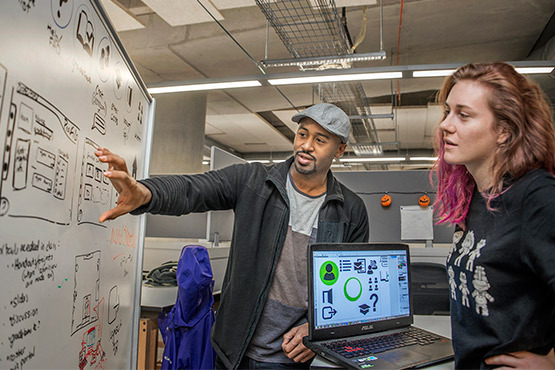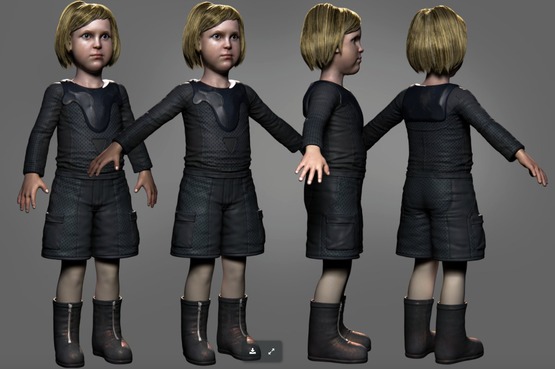
News . Feature Stories . Game Design holds lure of world-building for new department leader
News
January 23, 2017
Game Design holds lure of world-building for new department leader
'A light bulb went off - this was a legitimate industry'

Photo by Rob Muller/CIA. See a slideshow of the Robert's work below.
By John Campanelli
Growing up in Cleveland, Robert Brown spent a lot of time at the window.
He had other passions: martial arts, acting, video games and, of course, drawing, which became an interest the moment his artist mother first plopped her 5-year-old son in front of a piece of paper and handed him a crayon.
Yet something always got him to turn away from the Kung Fu magazines, movies, gaming console or drawings and run toward the window.
“What really excited me were tornados,” Brown says. “A cloud actually coming out of the sky and touching the ground. It’s magic. It’s a concrete form of magic.
“That became an obsession. I’d run to the window, look outside when a storm was coming and wonder if I was going to ever see one.”
He filled the 18-by-24-inch drawing pads his mother gave him with pictures of tornadoes plunging from the sky, destroying small towns and pulling up power lines. He vowed to become a tornado chaser.
Two decades later, you won’t find Brown leaning into the wind on the Weather Channel or breaking into your local station with the latest from Doppler radar. He’s on the third floor at CIA, where he is assistant professor and co-chair of the Game Design Department.
During a storm chase in his early teens, Brown got to see a “jumper” – tornado-chaser lingo for a funnel cloud – up close. It altered his thinking.
“That frightened me enough that I didn’t want to see a full tornado,” Brown says, laughing. “It was nature telling me, ‘Are you sure you want this?’ Not long after that, I knew I wanted to get into the arts.”
He dived into his drawing, focusing on the martial arts. He researched the origins of Kung Fu and studied ancient Chinese culture. He invented elaborate characters with rich narratives. He completed countless illustration studies of Chinese monks, traditional Far East clothing and the human form.
At around 14 or 15, Brown started noticing ads in magazines for job openings for game developers. “A light bulb went off: This was a legitimate industry with 9-to-5 positions,” he says. “I realized that I could actually make a career of making games.”
With video game design, Brown discovered he could combine his passions – martial arts, acting, drawing, technology – and create characters, environments and situations just as exhilarating and magical as a tornado dropping from the sky.
He decided to attend CIA, he says, so he could receive a stellar arts foundation along with digital-media and game-design expertise.
Among other work, his senior thesis featured an exploration of a character named Golconda, whom he created when he was 12. Brown incorporated 3D sculpting, texturing, rotoscoping, video editing and more. He created poses for Golconda that became letters of an alphabet. But beyond that, his made the character a representation of himself, giving it a full persona and setting it on a quest through the desert for inner peace.
“It was a pivotal moment in my character-creation process,” he says. This was Brown pouring not just brilliant draftsmanship into his work but artistic emotion.
And he hasn’t stopped.
After finishing CIA in 2007, Brown worked as a game developer for EA Sports in Florida, lending his character design and modeling talents to NFL and NCAA football games for the PlayStation and Xbox 360, among other work.
When a teaching opportunity opened at nearby Full Sail University in Orlando, Brown jumped at the chance to teach 3D modeling and character design.
In 2013, he was contacted by a course manager at the Media Design School in New Zealand. They’d seen his portfolio online, were impressed and wanted to talk to him about teaching Down Under.
“I’d heard great things about raising a family in New Zealand, because I had my first son at this time,” Brown says. “Fast forward a year, and we were on a 19-hour flight to Auckland with everything we owned.
Brown says that in many ways, New Zealand was a paradise – nice people, great food, a less-frenetic culture. But the high cost of living made it impossible to build savings. When his wife began expecting their second child, they knew it was time to head home to the support of family and friends.
Since arriving at CIA in July 2016, Brown has been busy.
He has been updating the labs and adding equipment, including new headsets and other gear to boost the 3D and virtual-reality capabilities of the department.
He’s working to fill out the curriculum. Currently sophomores focus on basic game constructs, theory and strategies as they study and design simple games. As juniors, they learn about specific techniques and technologies along with getting lessons on concept development, team-based work and project management. As seniors, they are challenged to put it all to use.
Brown wants to add courses on the societal and cultural aspects of gaming and an examination into how people and characters have been depicted in games. Today’s CIA students already have a surprising understanding of culture and society, he says, and they are bringing that sophistication to their games.
His job, he says, is to teach — and then get out of the way.
“What I focus on is giving them the skill sets and the exposure to the hardware and the processes that are there for them,” he says, “and then to allow them to continue going on their own path of investigation.”
Brown has also begun work on a long-term objective of making Cleveland a gaming hub. He is reaching out to potential partners — developers, companies, associations — to create a local gaming conference to bring outside professionals to Cleveland.
His goal: “A graduating student body of strong multimedia artists who have a choice of staying in the city and opening their own companies as entrepreneurs or working for a triple-A developer and integrating immediately into their workflows with competent skills and knowledge of the software and hardware.”
Brown is also working to not only instill a love of gaming into his children but to use the power of a good game as a parental tool with his 5-year-old, Little Robert.
“If he wants ice cream, for instance, he’ll have to earn skill points for that,” Brown explains. “If he cleans his room, that’s two skill points. If he picks up his toys around the house he gets a certain amount of skill points.
“He’s learning to pick up after himself, but he’s also understanding that you earn rewards. You earn leisure. You don’t just get them for free.”
And for Professor Brown that means less time chasing his 5-year-old tornado.
Latest Headlines view all
-
April 02, 2024
Cleveland Institute of Art students partner with Progressive Art Collection to exhibit Ready, Set, Relay! -
March 04, 2024
Cleveland Institute of Art announces Curlee Raven Holton Inclusion Scholar Program -
November 06, 2023
Collision of art and artificial intelligence creates murky waters for artists, curators and educators
Questions?
For more information about this or other CIA news, contact us here.









Social Feed